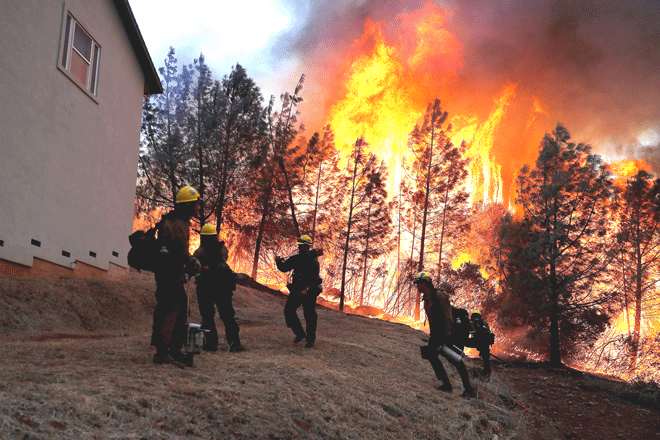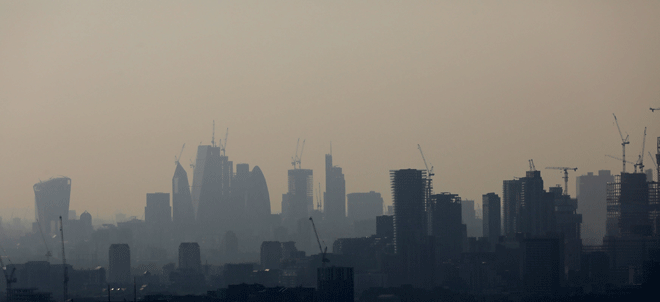
US Forest Service firefighters monitor a back fire while battling to save homes at the Camp Fire in Paradise, California. — Reuters file photo
A HAPPY NEW YEAR 2019 to all readers but let us not forget the weather events of 2018!
In the last six weeks of 2018, the Borneo Post daily published some fascinating articles on wild weather worldwide. I quote but a fraction of such events:
- Global warming outpaces efforts to slow it.
- Thousands evacuated as Australian bushfires rage.
- Northwest China hit by sandstorm as Beijing is smothered by smog.
- 2018 temperatures set to be among the hottest on record.
- Dangers fear for survival on India’s disappearing island.
- Climate change could cost US hundreds of billions a year.
- 79 Chinese cities triggered air pollution reports.
- Alarm sounded, nations urged to act at UN climate talks.
- Campaigners target coal at UN climate summit.
More doom and gloom, you may well mutter and in your next breath, question: “How does it affect me in Sabah and Sarawak?”
Read each daily paper carefully for you will find that the Malaysian Federal and State governments are putting plans in place to help mitigate the effects of climate change.
Rising Earth and ocean temperatures, sea levels, intensities of rainfall, persistent drought, crop failures, famine, landslides and cliff collapses are not “Acts of God” but mankind’s failure,in that he/she has triggered such catastrophes.
In early to mid-Dec 2018, the UN Framework Convention on Climate Change Conference (UNFCCC) met appropriately in Katowice, Poland, at COP 24 (Conference for the Parties of the Paris Agreement 2015) to discuss commitments to combat climate change.
Katowice, in Silesia, grew as a city from its coal and lignite (brown coal) deposits, used in thermal power stations worldwide with their toxic emissions of greenhouse gases, to generate electricity.
In the opening speech at that conference Vice President Sefcovic stated: “We will not forget the most vulnerable parts of the world, because our climate action is not inward-looking and because climate change has no borders.”
In the conference’s closing speech, Antonia Guterres, the UN Secretary General, in referring to our failure to tackle climate change, aptly concluded: “It’s not only immoral but suicidal!”
Perhaps it was a 15-year-old girl, Greta Thunberg, in her speech to the conference members on behalf of the world’s youth, who forcefully said: “We will have to live with the mess that older generations have made. We will have to clean it up for them. That is not fair!”
Her cri de coeur made politicians take the problem of climate change more seriously.
The answer is blowin’ in the wind

Buildings and construction cranes seen through a heat haze in London. — Reuters file photo
Few of us may remember the US artiste Bob Dylan’s famous song with its refrain — The answer is blowin’ in the wind my friend, the answer is blowin’ in the wind.
In early Nov 2018, Southern California, which had suffered from a prolonged drought, was hit by the Devil Wind — the Santa Ana. This violent downslope (katabatic wind) blasting through the Santa Ana Valley often occurs in late Spring to early Summer with warm and low relative humidity air.
So why in the last year did this wind occur in November? It was because exceptionally high pressure existed inland in the great Basin and Mohave Desert while a very low pressure cyclone existed over the offshore Pacific Ocean.
Winds blow from high to low pressure air and in this case along a very steep pressure gradient. The local vegetation was bone dry and perhaps a dropped cigarette or the embers from a barbecue started a small fire, to be fanned by the violent dry Santa Ana wind.
Over 62,000 hectares of vegetation and 13,600 houses were destroyed within a few days, resulting in an unprecedented number of deaths and unaccounted persons in California’s history.
Such sudden downslope winds have seen raging forest fires in Portugal, Spain and Mediterranean France in the last few years as well as wildfires burning thousands of hectares of moorland in northern England.
Australia did not escape wild fires in Nov 2018 with Queensland reaching temperatures of 40 C with 40 kilometres per hour winds fanning bushfires and causing the evacuation of 6,000 people.
At the same time, Sydney was engulfed with torrential rain in just one day when the equivalent of the monthly average rainfall fell, resulting in flash flooding and property damage.
Similar flash floods have been witnessed this year in both Sabah and Sarawak, with local elderly residents implying that they have not seen the likes before. Such wildfires and flash floods are here to stay as part of a global picture as weather patterns change and become more unpredictable.
Urban pollution and health
Dec 1952 saw the world’s deadliest smog, lasting for five days, shrouding London and causing the deaths of 10,000 people through respiratory problems, heart attacks and strokes.
Whilst the government declared it a natural disaster, public outcry led to the passing in Parliament of the 1956 and 1968 Clean Air Acts, banning the use of coal in major cities.
Between 2014 and 2016, worldwide, we have seen a rise in carbon dioxide levels as 40 per cent of the world’s electricity is generated at coal-fired power stations, doubling that of solar and wind power.
China, in contrast to its ever increasing self-preservation, is investing in a large number of coal-fired power stations in various African and Southeast Asian countries.
Dirty skies, with pollution alerts, were reported in early Dec 2018, in 79 Chinese cities to include Beijing, Shanxi, Henan, and Jiangsu.
India’s Delhi is declared the most polluted city in the world where, in the first week of last Dec, the city was smothered in toxic haze, exceeding safe limits by over 30 times. Over one million Indians prematurely die each year from the effects of atmospheric pollution.
Delhi suffers from westerly winds during the year, bringing in smoke from nearby farmers’ crop clearing fires which mixes with car and factory emissions and other manmade pollutants.
Increased urbanisation is affecting the levels of atmospheric pollution on a global scale simply because of, ironically, the greater concentrated emissions of greenhouse gases.
Interestingly, in mid-Dec 2018, research scientists at University College, London (UCL) published a report on the decline of human cognitive performances with increasing CO2 levels.
The natural level of CO2 in the air is but 273 parts per million, yet will increase by five times by 2100 through ever-increasing petrol, diesel and gas burnt emissions.
This, in turn, will lead to an ever-increasing afternoon lethargy in work places, commonly known as “the sick building syndrome!”
Flash flooding and landslides
We read last year about severe flash flooding in Miri and more locally in Kuching at Batu Kawa, Batu Lintang and around Sarawak where flood drains have been unable to take the intensity of rainfall falling during thunderstorms. Roads too exhibit huge puddles of water which could lead to vehicle aquaplaning accidents.
I have noticed over the years that whilst sub-contractors regularly keep grass roadside verges under control, may be it would not be a bad idea that they collect roadside rubbish before trimming, rather than shredding plastic amongst the grass only for the bits to be blown by the wind into the nearest drains.
One Kuching school was flooded because the road drains were blocked with plastic debris. If drainage is to meet a state of equilibrium where output equals input, then flash flooding can be averted.
This problem is not peculiar to Sarawak, for on the rural roads alongside my house in Somerset, UK, local farmers are sub-contracted by the council to flail hedges in late Aug. The cuttings lie in the road, thus blocking drains and I find myself several times each year unblocking the drains to prevent dangerous pools of water accumulating!
All over the world last year, tremendous landslides and coastal cliff collapses occurred, costing lives and livelihoods, mainly due to the increasing frequency and intensity of heavy rainfall. This is, no doubt, due to increasing land and ocean temperatures with ever increasing evaporation rates. What goes up must come down with, especially, deforested slopes becoming oversaturated and, thus, bulging!
South American countries have been badly hit on steep slopes where shanty towns or favelas have been built on the edges of main cities.
The landslide on Canada Hill, Miri, several years ago, still rattles in my brain. We cannot escape the fact that climate change is not a myth but reality!
Outcome of COPT 24 confab
I wait to read the official report but I am optimistic the nearly 200 nations at that conference have all agreed to a vast reduction in our annual temperature rises, with developed nations assisting the less fortunate nations in developing alternative methods of heating and power supplies other than from coal, wood, gas, and oil, in a serious attempt to reduce greenhouse gas emissions.
Politicians must now put their rhetoric into practice today, for tomorrow will be too late. Our only home is Earth!
Bob Dylan sang it all in his protest song of the 1960’s — How many times must a man turn his head, pretending that he just doesn’t see? The answer my friend is blowin’ in the wind, the answer is blowin’ in the wind.
The winds of change of 2018 have not only seen political changes worldwide but have been dramatically illustrated in the ever changing weather patterns all around the globe.
